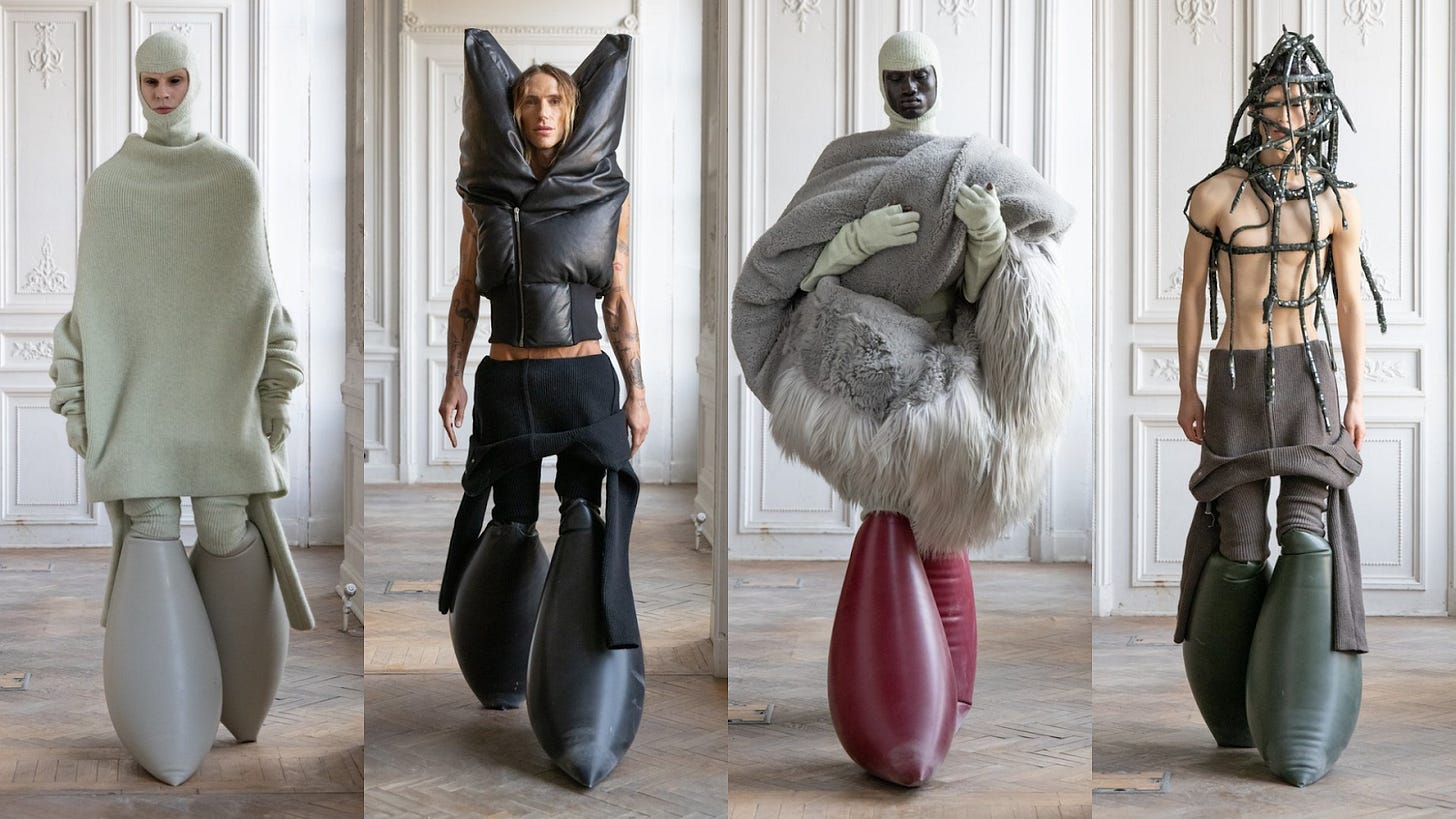We are in an era where the future is so uncertain, our lives are under such scrutiny, and we’re fighting harder than ever to be noticed and appreciated by an ever-changing, trend-based society. If you’re not riding the post-pandemic wave of hedonistic glory, you’re having a “soft girl” moment bundled up inside, or even worse, in a rebrand between the two.
There is a cultural demand for sexual autonomy, futuristic ideation, rebellion, and out-of-the-box sophistication that is operating parallel to the conservative Ralph Lauren “quiet luxury” narratives of 2024. Amongst the crossfire, latex, a fabric previously highly associated with kink and nightlife, has become one of the most prevalent fabrics in the most well-respected high fashion environments.
Latex’s rise isn’t isolated—it’s part of a larger movement embracing experimental textures and self-expression in fashion. As consumers crave bold, tactile materials that reflect their individuality, latex has emerged as a statement fabric used to evoke power and stand out within a market where it has never been more oversaturated with trends and brand stories.
No Longer Taboo
From taboo to the hottest high fashion fabric of 2024, the meteoric rise of rubber clothing this year can be seen industry-wide. Found on the red carpet, arena stages, press tour interviews, and on the runway, anyone who wants to have their finger on the pulse will acknowledge latex within their fashion radar.
The trend may have slipped under your nose if you only think of latex solely as catsuits and corsets. But to the trained eye, there has been a significant shift in the industry in material exploration, garment construction, and fashion storytelling because of latex.

The Many Misconceptions of Latex
It’s imperative to understand that real latex clothing is 100% rubber. Meaning it does not carry the qualities of traditionally knit or woven fabric. While fabric is composed of a complex web of wafts and wefts, fibers that have been spun in order to be woven or interlocked to make sheets of material, latex on the other hand is straight-up rubber. Secretions of liquid latex collected from the rubber tree (Hevea Brasiliensis) are then coagulated into solid sheets.
Latex fabric is 100% natural, but it cannot be traditionally sewn because it is not made up of spun and woven fibers. Latex is cut out and then glued together. The lack of general knowledge about how latex (and clothing in general for that matter) is made, leads to many misconceptions about what is and what's not latex. Spandex, vinyl, PVC, and PU leather are frequently confused or marketed to be “latex” when they are not at all the same processes chemically or constructionally.
For centuries, designers have been working with fibers, knits, and thread to construct garments. There are thousands of different blends, classifications, and weaving structures that designers have explored. However, latex is on an entirely different playing field than that of traditional fabric. Leaving room for a world of possibilities.

Latex can hug, slink, and meld itself to the body if cut properly. Its rubber texture is a unique sensory experience. Unlike traditional fabric, it can adapt to the ambient temperature around the wearer. However, the rubber can cling and drag onto your skin without the use of talcum powder or a silicone oil dressing aid. To avoid chafing and to slip into tightly designed latex pieces, the wearer must lube both themselves and the garment in a dressing aid before putting the pieces on. The process is rather ritualistic and can be intimidating to the unfamiliar.
In two red carpet interviews this year, Entertainment Tonight interviewed Christina Ricci at the Critics Choice Awards and E! News interviewed Chrishell Stause at the People’s Choice Awards, who both happened to be wearing variations of Atsuko Kudo Tulip latex gowns. The stars gingerly describe the process of adorning the garments with a polite awkwardness.
“You lube your body up…It was a new experience for me!” says Ricci.
“It involves a little bit of a lube to get into it but uh…” Stause chuckles and shrugs “Have fun with it!”
Latex on the Red Carpet: The “It-Girl” Dress
Despite any trepidation, in 2024 stylists were lunging at the prospect of getting their stars into a striking latex gown for the red carpet.
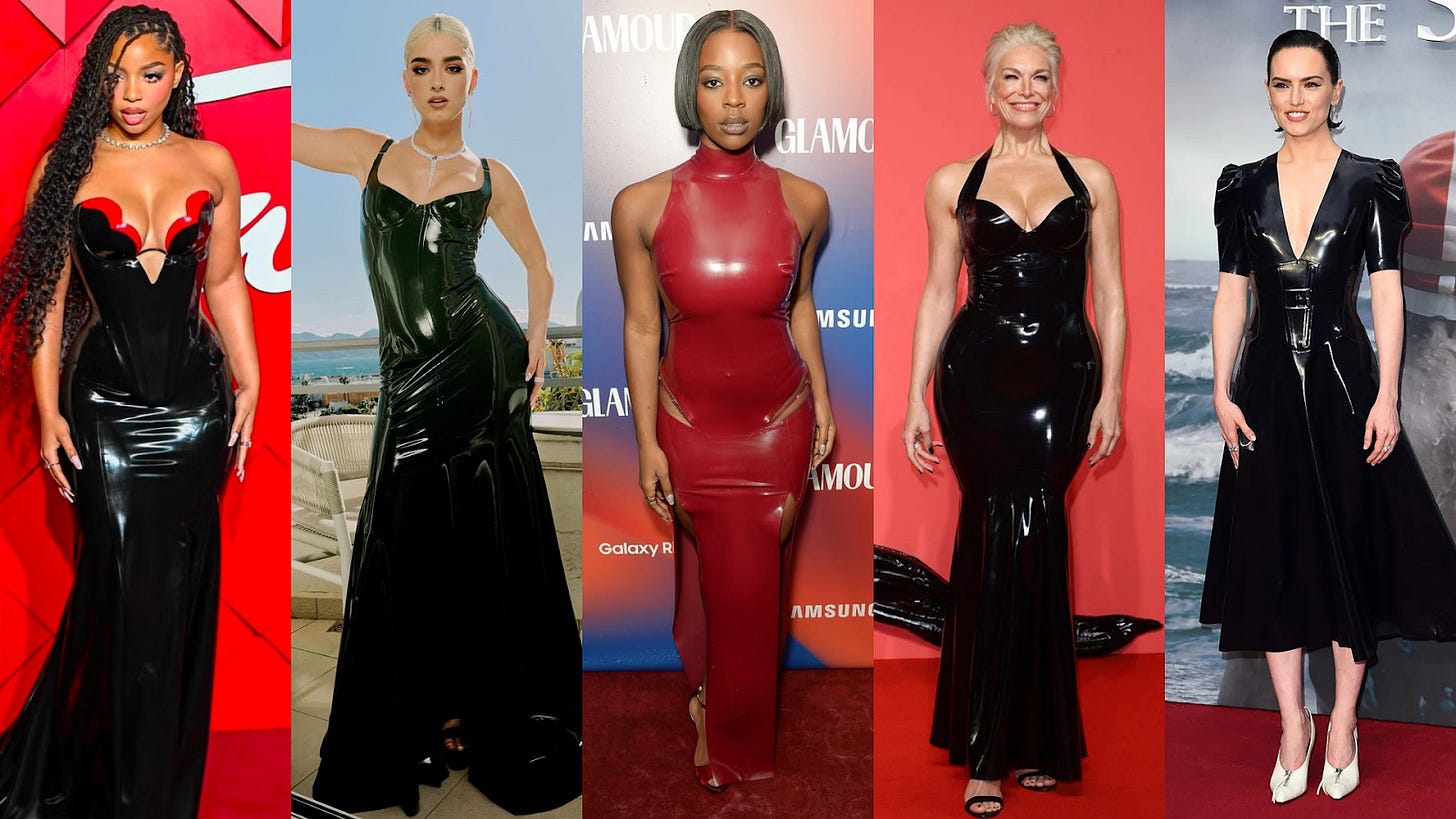
The snatched waist, glossy sheen, and taut breasts create stunning silhouettes that turn these stars into fantasy pin ups. These looks are certainly sexy, but the way that material ensconced the body, lifts, and smoothes it out, is a feat of architecture. Many of the conventions of fashion design involve flattering and abstracting the conventional hourglass female form. Latex creates bombshells, and stylists are seeking out latex to turn their clients into “it girls.”
There is something very empowering about a simple, yet perfectly tailored fit and flare gown. Even without its shiny luster, latex amplifies the shape of the body and keeps everything in the right place because of its chemical makeup. Halle Bailey absolutely stuns in this textured latex gown at the BET Awards this year. Just 6 months postpartum, Bailey is gracing us with the dips and curves of her body and doing it flawlessly.
The cling of the material to her figure, the visible dips of her belly button, the draping of the fabric as it hangs heavier to the ground, none of the qualities of what make this look so jaw dropping would be achievable without latex. Latex is a statement. If it's designed with the intention of being tight, then there's nowhere to hide.

Not Always Tight and Cinched
However latex is not exclusively a medium for tight fitting ensembles. Designers like Avellano, Monique Fei, Harri and many others are redefining the context and construction of rubber clothing.
Avellano produces stunning latex button ups and trenches. The wet look and lazer sharp tailoring are essential to the brand’s matrix motifs. There is something very neo-noir about the brand’s identity. Avellano’s team keeps their colors to a limited swatch set, and allows the construction to speak for itself. Timothee was spotted multiple times in Avellano during the Dune 2 press tour.
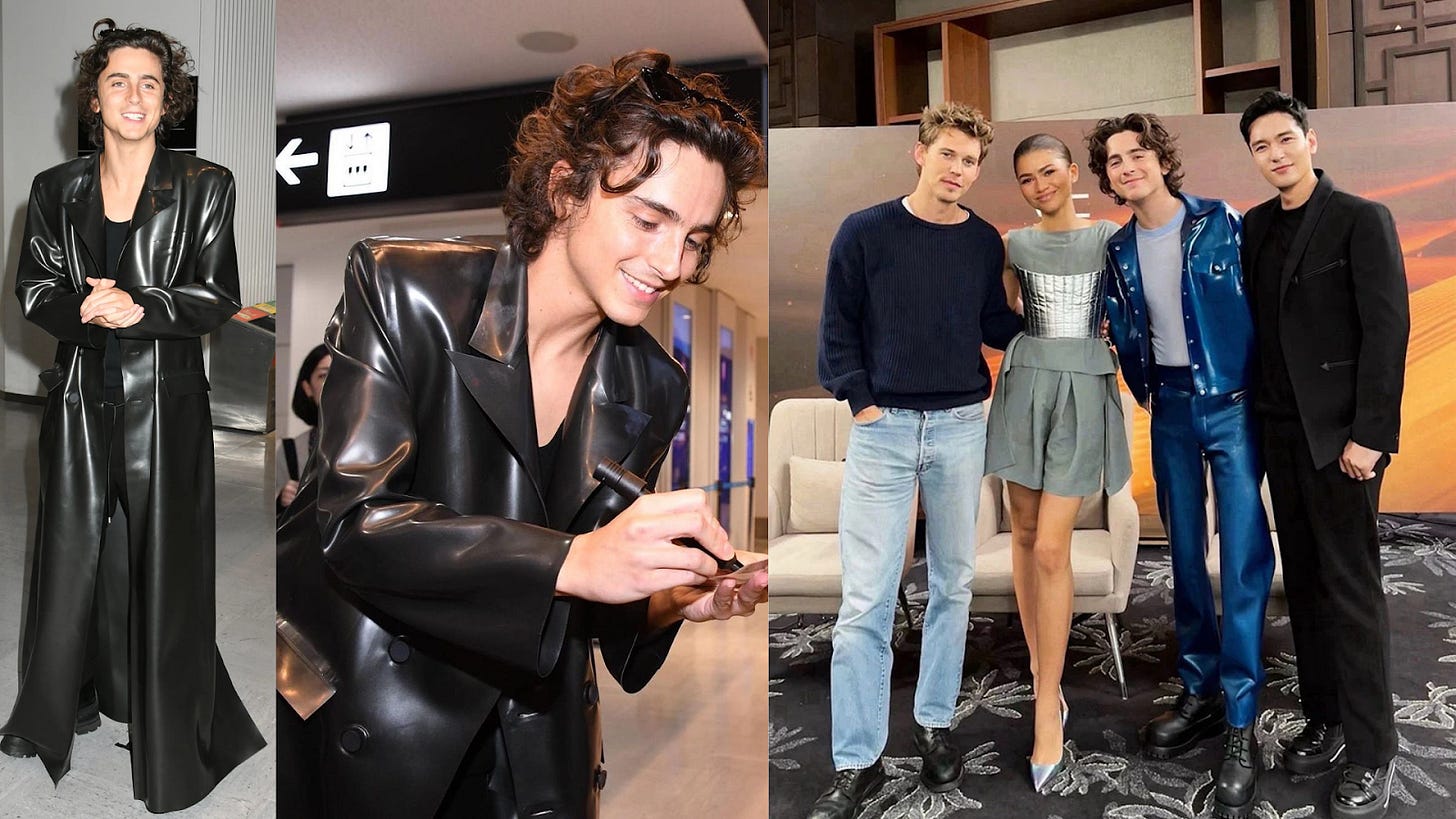
Doja Cat wore a custom Avellano set, a translucent body suit and trench paired with office siren glasses for a melted “corp core” ensemble during her London live show this year.

As if it couldn't get more sartorial and modest, Kris Jenner wore a matching white high neck bodysuit, tailored trousers, and a shawl lapel trench, all by Avellano. This is a 68 year old woman dripped head to toe in latex, and she looks snatched, powerful, and appropriate all at the same time.

Avellano is passionate about re-framing the stigma around the material to not be exclusively sexual. It’s important to note that these tailoring techniques are extremely difficult to achieve just by gluing the pieces together, latex designers have to be ready for experimentation and trial and error. In a 2018 interview with Metal Magazine, Arthur Avellano explains:
“Working with latex requires a lot of research – this is one of the reasons why I keep developing this material. At a very early stage, I was told to stop using it because it’s not wearable and difficult to sell – people still envision latex as something related to sex –, and I persisted because I found the challenge interesting. I spent time researching how to make it wearable…”
The Rise and Fall of a Latex Princess
It's clear that Chappell Roan and her stylist Genesis Webb have an affinity for rubber. During the iconic Chappell Roan outfit circuit of 2024, a significant number of the artist's most memorable looks this year were designed by latex artisans.

Her most notable latex look however, is undoubtedly her Lady Liberty look for Gov Ball 2024 designed by Monique Fei. Painted head to toe in green body paint, smoking an ounce sized joint, and emerging from a half eaten apple were not even gag worthy enough to combat Chappell’s glorious assless chaps. It’s campy, it doesn't take itself too seriously, and it’s a return to a bygone era of pop stars delivering a true spectacle.
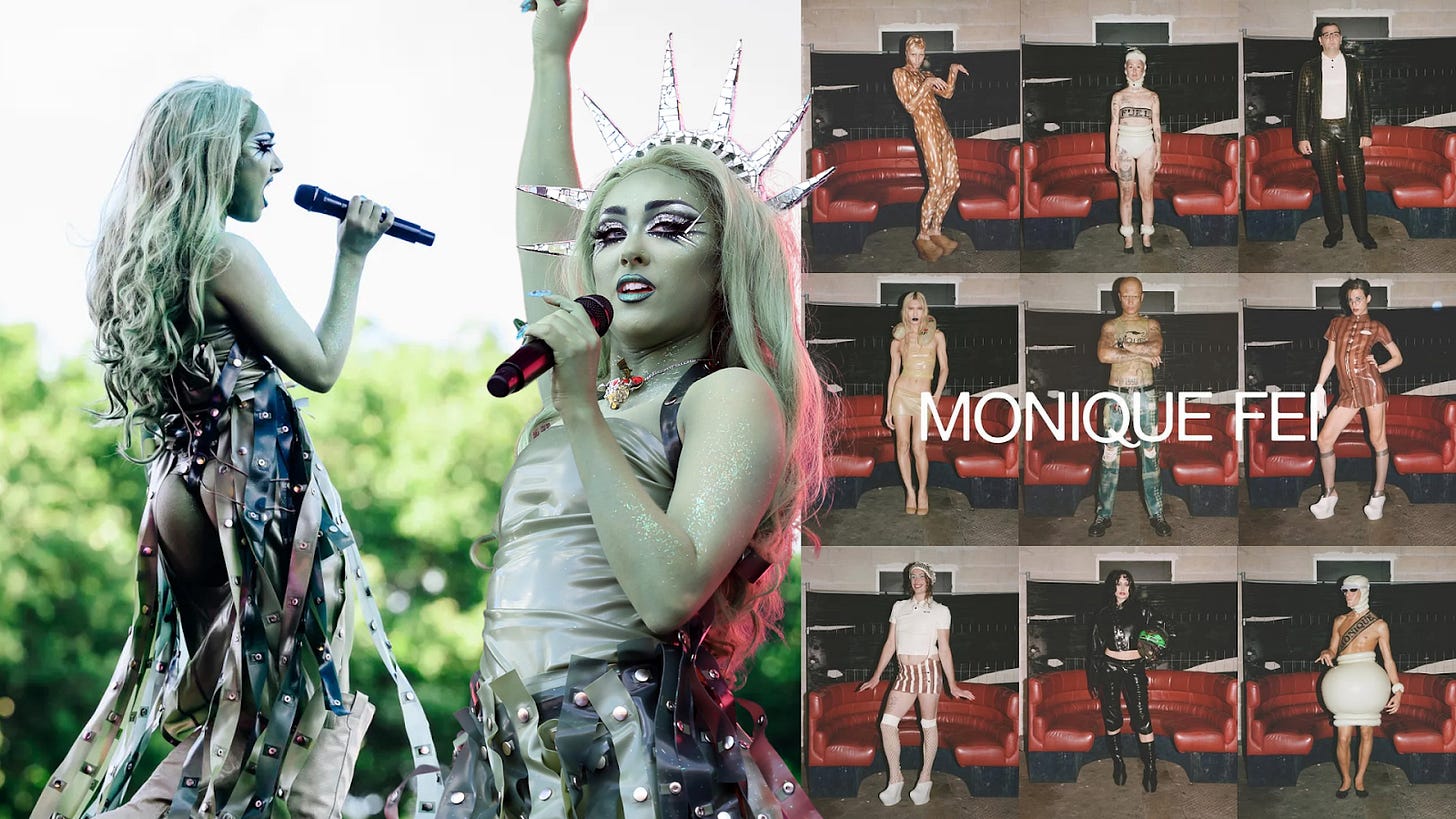
The latex here is not constructed with the typical intention to be tight fitting, rather the material shines through its other properties. The shiny/wet looking qualities and the heavy drape of the rubber studded skirt strips are instead utilized to emphasize the image of wet copper. It's a subversive use of the material that doesn't just take the obvious route of what “sexy” would look like. These design conventions are a staple of Monique Fei’s twisted, yet brilliant interpretation of rubber clothing. Out of all of Chappell’s latex designers, Monique is who I have my eye on the most.
The Inflatable Controversy
There are other designers who push the envelope even more to subvert the conventions of fashion using latex. Latex can inflate, and produce smoother curves that other materials just can't produce. Designers can morph and abstract the human form using inflated latex in very creative ways, some more unorthodox than the next…

Despite how meme-worthy the look has become, it’s still iconic, and a technical feat of design. These pieces have to be cut exactly right to accommodate the bending shapes of the desired look. There is so much opportunity for exploration and storytelling by manipulating latex into these amorphic plush appendages. In a BBC interview, Harri acknowledges the mixed reception that his work receives, and embraces it.
"I'm passionate about making something that makes people think and talk and discuss," says Harri.
Another innovative latex designer is Fredrikt Jaerandsen, a 2019 Central Saint Martins Graduate who stunned with his BA collection of inflatable latex. After graduating, Jaerandsen shifted his focus to art and performance art installations within museums across Europe. He uses latex to incite awe, discomfort, and new sensory experiences. Jaerandsen has even created art for clubs, describing it as “A fusion of an Audiovisual exhibition and a Dance Party” on his instagram.

Yet somehow the limits can be pushed even further. Techniques can be experimented with to the point of pure insanity. In a feat of craftsmanship and a display of maniacal creativity, we receive the STRAYTUKAY MEGA-PUFFER. This colossal latex inflatable jacket inflates to expose emerging tendrils of latex sculpture, and its size and construction is truly jaw dropping.
Rubber on the Runway
Work like that of STRAYTUKAY is very impressive, and soon enough the 21 year old CSM student would be noticed by Rick Owens. Overnight, the (still enrolled in university) student would become the hottest new protege in fashion. The inflatable rubber of STRAYTUKAY would become infused with the Rick Owens brand during the FW24 Porterville men’s runway collection.
This collaboration was a match made in heaven. STRAYTUKAY has the construction and architecture, and Rick styles the boots as if his models are soldiers in an arctic dystopia. The shape is innovative, the silhouette is charming, and I can't help but want to squish my feet inside a pair of them myself!
It’s very fitting that Alaïa, the “King of Cling” would employ latex in their designs. The WS 24 collection featured glossy, foggy latex skirts, double breasted military dresses, and trenches. Inspired by the “elastic notion of time”, it’s clear that Pieter Mulier is working at the precipice between timelessness, and futurism. There’s no other quote that describes the unique nature of designing with latex other than—
“Seams trace not only the form of the body but the life of these clothes, like timelines charting their evolution and refinement, the process behind their invention.” - Alaïa WS 24 collection statement.
The house of Alaïa has always been known for the most form fitting tailoring. Alaïa’s fashion architecture revolves around complimenting the natural lines of the female form.
“I dressed women directly on their body, by intuition. This is how I gained experience.” - Azzedine Alaïa, 2013
As if pure ethos and logos were melded together, the credibility of the Alaïa label goes hand in hand with the technical prowess of latex. It's not highly surprising to see latex on the 2024 catwalk considering designers like McQueen and Mugler have been using it for years. However these high fashion juggernauts are approaching the material with a conviction of exploration. Owens and Mulier recognise that latex has potential, stylistically and architecturally.
Latex in Editorials and Publications
This same Alaïa collection has been making its rounds in the editorial space this year. Cara Delevingne and Anne Hathaway wore the same high necked burgundy pencil dress in stories for The Standard and Vanity Fair. These images are powerful, sensual, and almost feel like a reclamation of their own bodies. The poses are autonomous and the styling makes these ladies radiate with triumph.
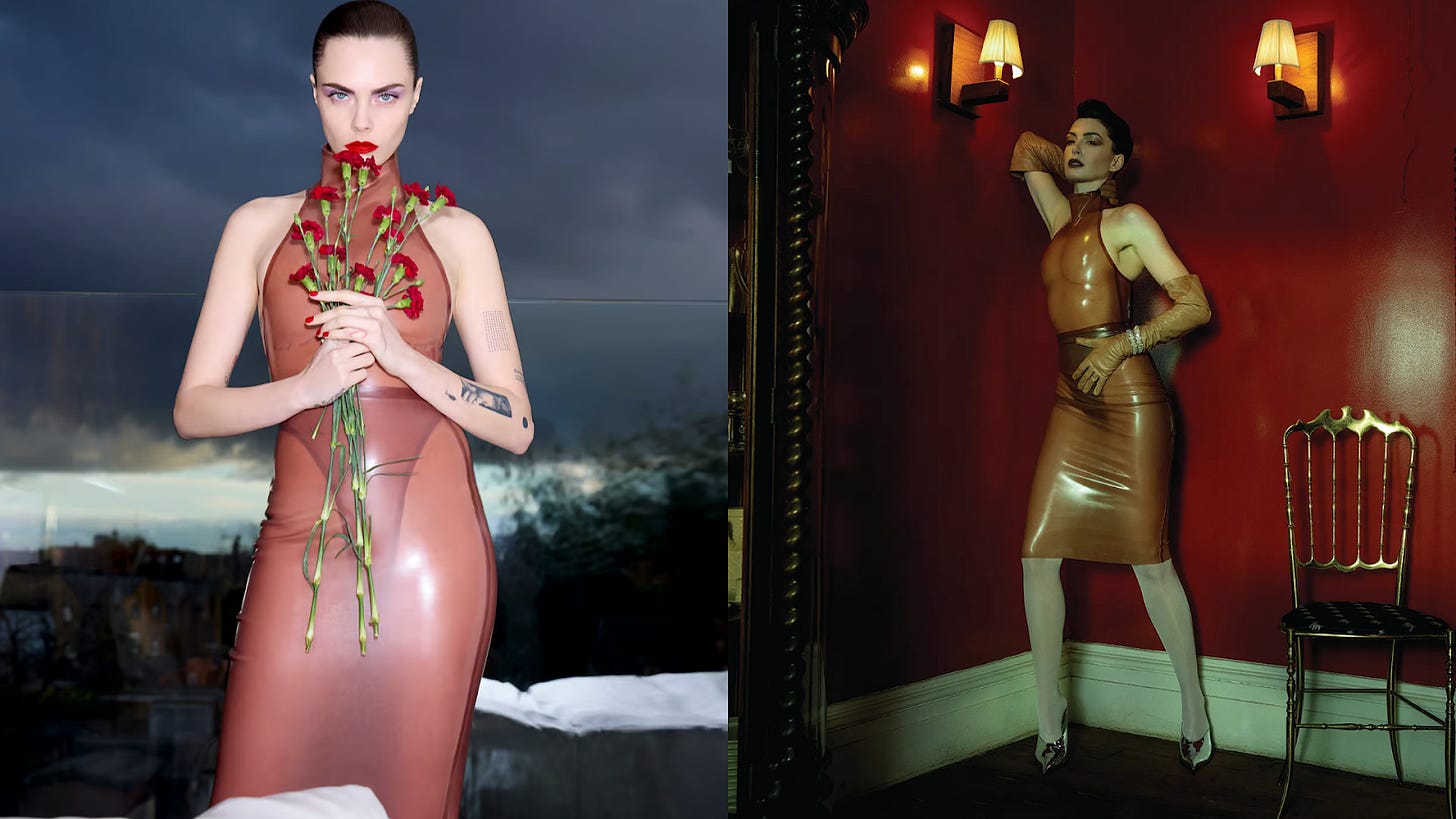
You can also spot latex accessories in publications like W magazine and GQ. The sheen of the material really pops within both of these monochromatic ensembles. Once again, these images evoke a sexual subtext, but are overpowered by the confidence that this material exudes from the wearer.

The Latex Epoch
Keep an eye on latex as a trending material in 2025 and beyond. Early adopters have set the stage, but rubber clothing still holds untapped potential. Far more than a shiny, stretchy fabric, latex demands care, time, and skill to craft. Unlike conventional textiles, it can't be zipped through a sewing machine in a sweatshop, and its intricate techniques are often self-taught rather than institutionally trained. These challenges of mastery are a small price for the boundless creative possibilities latex offers.
Latex may never fully shed its sexual connotation, nor should it need to, to be valued for its luster, versatility, and innovative potential. Once dismissed as crass or utilitarian, latex’s rise in high fashion underscores the industry’s drive to disrupt and evolve. By pushing technical and cultural boundaries, latex empowers wearers and redefines its place in fashion—not just as a trend, but as a revolutionary material.
As the trend cycle moves swiftly through latex, some brands will undoubtedly attempt to capitalize without authenticity. Watch for pieces that mimic latex but fall short in quality or construction, and call out misleading marketing. Most importantly, support small latex artisans who keep the craft alive and are pioneering new innovations in rubber fashion.
What’s your favorite #latex moment of 2024?
Final oversight and edits by Amarissa, Founder & Editor in Chief of Fashion Talk.
connect with us: IG → pinterest → X → bluesky







